
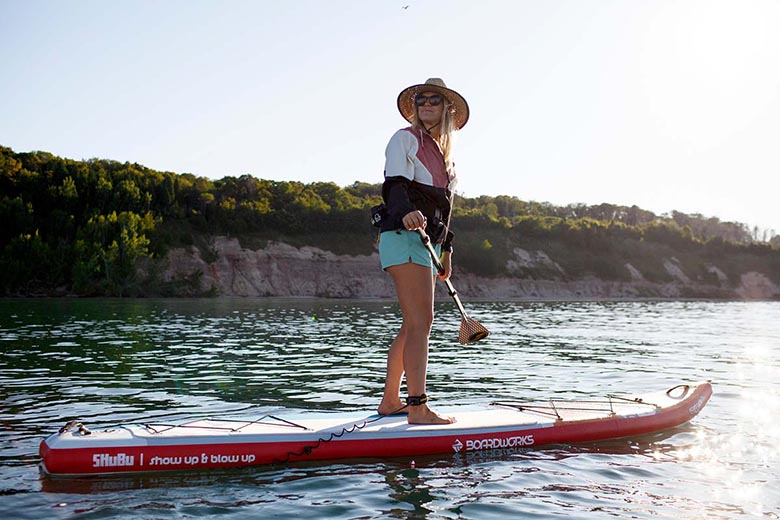
Stand up paddle boards (SUPs, for short) are a great way to get out on the water, whether you're trying to explore coves, catch fish, or relax in the sun. These compact vessels are surprisingly durable, stable and efficient on the water, and versatile for activities like fishing, surfing, and just plain cruising. Below we break down the top stand up paddle boards of 2025, from recreational models perfect for beginners to premium touring boards and activity-specific designs. For more information, see our buying advice and comparison table below the picks, as well as details on how we test paddle boards.
Editor’s note: We updated this guide on June 27, 2025 to add the Dax Board Company DownDog 11'6" as our favorite hybrid SUP, as well as their Drifter hard board to our list. We swept the article to ensure all information was up to date at the time of publishing, which involved removing discontinued or out of stock models, refreshing specs (we added a width spec for each board), and adding feedback from recent testing to their respective reviews. Lastly, we added a few photos from testing at Lake Tahoe, California, and Hawaii.
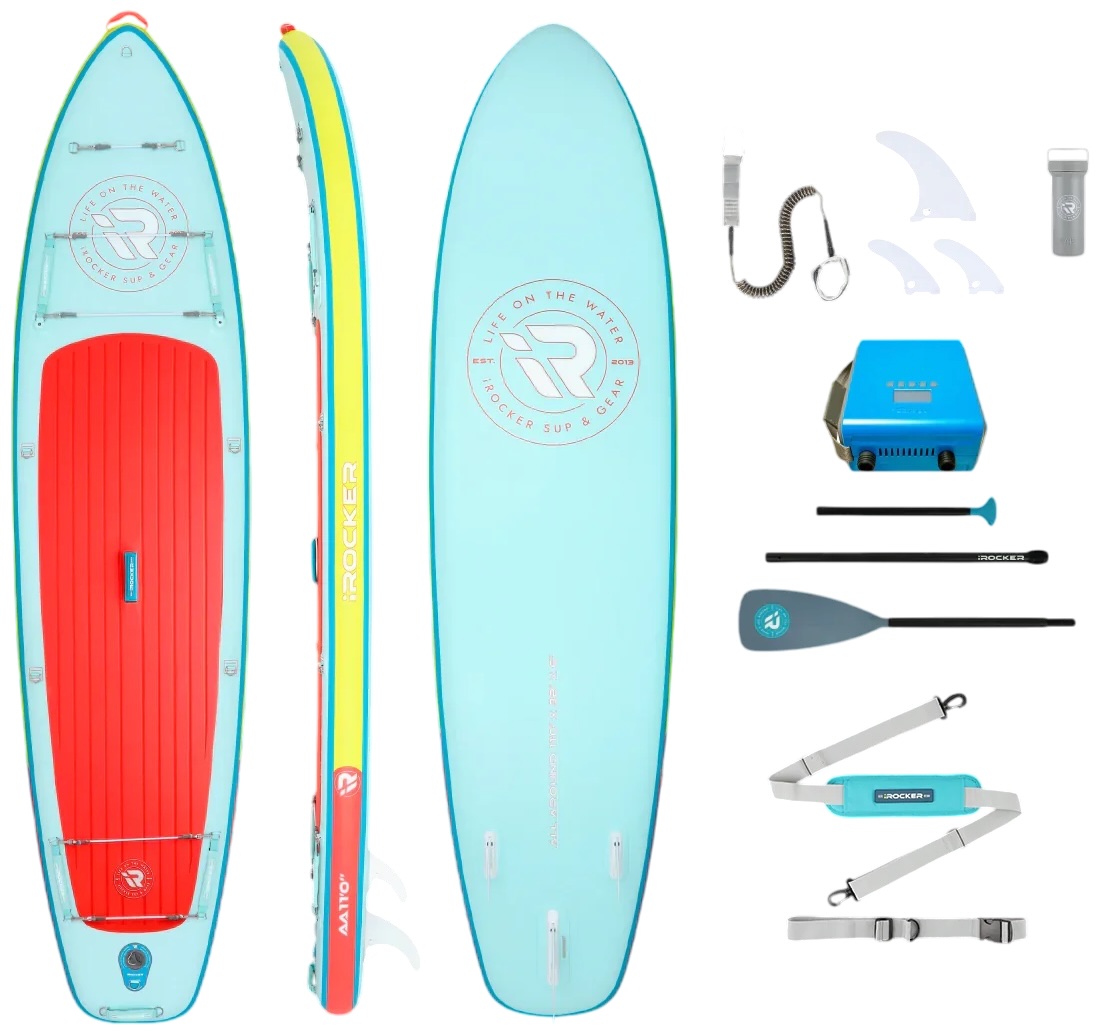
Category: Recreational
Lengths: 10', 11’
Width: 32"
Fins: Tri
What we like: Great value for a versatile and well-made board.
What we don’t: Not the fastest or most stable board on this list; no longer includes a travel backpack.
For the best combination of quality, affordability, and convenience, the iRocker All-Around 11' tops our list of stand up paddle boards for 2025. In short, the All-Around is the full package for those just getting started: You get a premium board from one of the top brands in the industry, in addition to a leash, electric pump, removable fins, and lightweight carbon fiber paddle (though, we're sad to see the kit no longer includes a travel backpack). On-deck storage is fully functional for most uses, including an assortment of D-rings and cargo bungees, and the generous pad can even pull double duty as a yoga mat. It all adds up to a great starter kit that’s plenty durable to last you well into your paddling career, whether you’re out on the lake, down by the bay, or even catching a bit of whitewater.
The All-Around finds a nice middle ground between budget models and premium boards, which is also reflected in the price. It's admittedly not the most high-performance SUP here—the Red Paddle Co Sport below is faster—but the iRocker is everything you'll need for flatwater paddling, and its build quality far exceeds that of more affordable designs. We also love the All-Around’s option for a single, twin, or tri-fin setup, which allows you to tailor stability and speed depending on your needs. Finally, owned and operated by paddlers, iRocker is known for their great customer service, along with a competitive warranty (one to three years depending on the board and issue). Experienced paddlers—including confident beginners—might also consider stepping up to the All Around 11' Ultra (out of stock at the time of publishing, but we’re optimistic it will return), which is pricier but nearly 5 pounds lighter and much more compact.
Read more: iRocker All Around 11' review
See the iRocker All-Around 11'

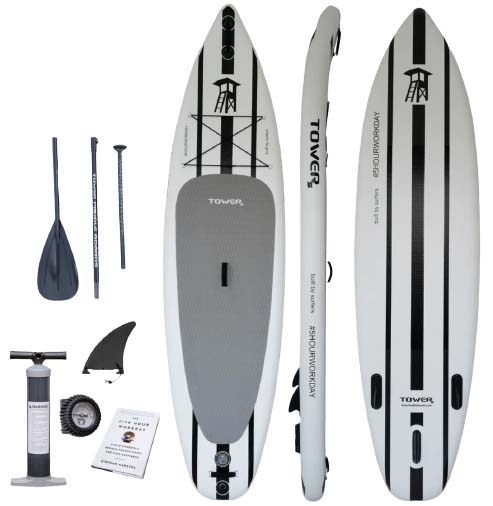 Category: Recreational
Category: Recreational
Length: 10’4”
Width: 32"
Fins: Tri (fixed side fins)
What we like: More durable than most SUPs at this price.
What we don’t: Suffers in choppy conditions and doesn't come with a travel bag.
Budget paddle boards can run you as little as $200, but most are plagued with thin, single-layer construction that can result in durability and rigidity issues over time. While this can be serviceable for new paddlers who haven’t experienced the joy of a rigid, skookum board, we don’t recommend it for heavy use. If you’re looking to pinch pennies but don’t want to compromise on quality, the Tower All Around is a great place to start. With fusion construction that’s twice as thick as a single-layer board, the All Around offers similar durability and rigidity to most premium models here, including those from iRocker, Red Paddle Co., Isle, and more. We recently took the All Around out in Hawaii and found it to be a stable ride for both solo and tandem riders. Plus, the tapered shape and three-fin set up makes it easy to maneuver in flat water.
However, no board is without faults, and we experienced some performance issues in Hawaii when the wind picked up. The Tower lacks rigidity compared to more premium boards, making it a bouncy and unstable ride in choppy waters. You also shouldn’t expect a fast ride—because of its lack of stiffness, it has drag issues and struggles to glide efficiently through water. And while it does come with all the necessary trimmings—including a detachable fin, three-piece paddle, and hand pump—Tower noticeably omitted a travel backpack, which we’ve certainly missed when schlepping the board from our shed to the put-in (you can purchase one separately for $59). That said, our tester dubbed the All Around as a “Goldilocks” model—it’s one of the least compromised budget boards on the market, making it a great choice for beginners wanting to dip their toes into the water (pun intended). It’s pricier than the cheapest board out there, but its price-to-performance ratio makes it our favorite budget board.
Read more: Tower All-Around Inflatable Paddle Board review
See the Tower All Around S-Class

 Category: Touring
Category: Touring
Lengths: 11', 11’3”, 12’6”, 14'0"
Width: 32"
Fin: Single
What we like: A high-quality touring design that’s rigid yet lightweight.
What we don’t: Doesn't come with paddle and leash and needs more attachment points for long trips.
U.K.-based Red Paddle Co (RPC) is an industry leader in paddle board innovation and design, with a top-notch selection of inflatable paddle boards for everything from whitewater and windsurfing to yoga and racing. Their Ride (offered in lengths up to 10'8") is one of the most full-featured all-rounders, but the longer Sport MSL is our top pick for paddlers looking to travel greater distances or at faster speeds. Hey You get a relatively narrow, 32-inch width for cutting efficiently through the water, a single fin for tracking (traveling in a straight line), 4.7 inches of platform that keep you svelte and close to the water, and a speed tail for both efficiency and maneuverability. Finally, with multiple sizes—11’0”, 11’3”,12’6”, and 14"0'—you can customize length depending on your weight (remember to factor in your gear as well).
It doesn’t get much more premium than a Red board, but given the Sport MSL’s price, ask yourself if you really need this level of performance. After all, touring models like the Thurso Surf Expedition below can get the job done for most paddlers at about half the price. But it’s hard to beat the durability of a Red board (they put them through extensive testing, including running over a board with a 22.5-ton tractor), which are all backed by a generous five-year warranty. Further, the Sport MSL comes with add-on stiffening battens for each side rail, which give it more rigidity while still maintaining a fairly low weight (however, these are so difficult to slide in and out that we often don’t bother). All in all, the Sport MSL is an ideal companion for fitness paddling or multi-day excursions. And for a larger deck to shuttle more overnight gear, the 13-foot 2-inch Voyager is a step up in size (it also comes in a 12'0" length).
See the Red Paddle Co Sport 11'3"
 Category: Specialty
Category: Specialty
Length: 10’
Width: 30"
Fin: Single
What we like: Light weight and impressive packability make it easier to tote long distances.
What we don’t: Featherweight design comes with sacrifices in durability and versatility.
Oh, the places you'll go on a stand up paddle board. And when your board packs down into an easily totable dry-bag backpack, the adventure list grows even longer. Kokopelli is known for their ultralight packrafts, but the Chasm-Lite makes it clear their ambitions lie in getting off the beaten path. With a weight of just 12 pounds 14.4 ounces, Kokopelli touts the Chasm-Lite as the lightest paddle board on the market—and after extensive research, we haven’t been able to disprove that claim. The whole kit packs down into a bundle that's 16 x 9 x 8 in. (for just the board). With this streamlined build, the hike to your favorite alpine lake becomes a whole lot easier.
That said, there are a few downsides to the Kokopelli’s light and packable design. First off, the drop in weight and ultralight materials come with sacrifices in durability compared to the board’s heavier brethren, which feature fusion or double-layer constructions that are much more confidence-inspiring and will hold up better over the long term. Its small size and relatively low load capacity (250 lb.) also make it unrealistic to paddle with abundant gear and a pet. And even though it’s pounds lighter than its closest competitor, it’s still double the weight of some packrafts, which are purpose-built for hauling deep into the backcountry. But SUPs are a versatile option for most—they're also just plain fun—earning the Chasm-Lite our vote as the best option for hitting the trail, paddle in hand. Of note: We previously had Pau Hana's 10-foot-10-inch Solo Backcountry ranked here, although it's around 2 pounds heavier and less packable than the Kokopelli.
See the Kokopelli Chasm-Lite
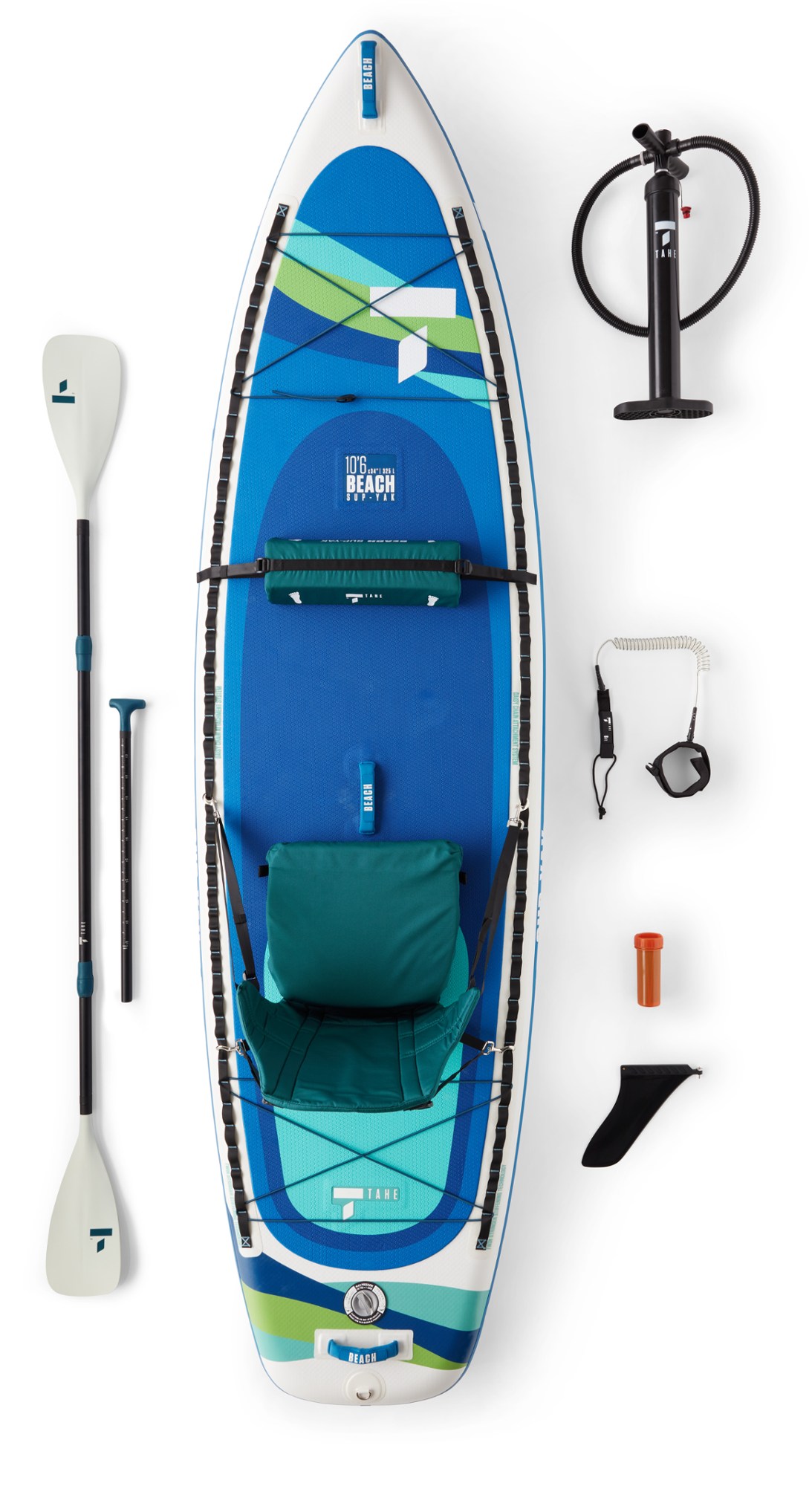 Category: Recreational/specialty
Category: Recreational/specialty
Lengths: 10’6"
Width: 34"
Fins: Tri (fixed)
What we like: Includes a kayak seat, footrest, and adjustable paddle; built-in daisy chain offers great customization.
What we don’t: If you already have a paddle board, you don't need all this. You could possibly purchase just a kayak seat to fit.
If you’re the kind of paddle boarder who likes to sit down from time to time, it’s worth looking into a hybrid SUP/kayak design. Tahe’s Beach SUP-Yak is our current favorite—you essentially get two activities in one. Without the included Kayak Kit, you get a standard-sized SUP with an extra-wide, 34-inch deck. Add the Kayak Kit, which includes a raised seat, footrest, and adjustable paddle, and you get a comfortable sit-on-top kayak. Rated for up to 300 pounds, the 10’6” Beach SUP-Yak is sturdy enough to handle you and your smaller loved ones (be it furry friend or child) with ease.
A lot of paddle board brands give you the option of adding a kayak seat to your order, including iRocker, Blackfin, Isle, and Thurso. But what we love about the Tahe is its daisy chain attachment system, which runs the length of each side and allows you to situate the seat exactly how you want it. The plush footrest is also a welcome feature for both comfort and performance—with something to push your feet against, you can move a lot of water with each stroke. Added up, there’s a lot to like about the Beach SUP-Yak. If you’re willing to spend a little more, the Isle Switch 3 offers similar features and versatility in a more premium package.
See the Tahe 10'6" Beach SUP-Yak
 Category: Recreational/specialty (hard board)
Category: Recreational/specialty (hard board)
Lengths: 12’, 15’
Width: 33"
Fins: One
What we like: Performance of a hardboard with the comfort and durability of an inflatable board.
What we don’t: Not featured enough for true all-around use, not wide enough for dedicated yoga use; price doesn’t include accessories.
South Lake Tahoe-based Dax Board Company has been in the SUP game since 2012, and their collection of inflatable and hard boards are sleek and stylish (we especially love the look of their Eco-Timber fleet, which features classy wooden boards). But in recent testing, the DownDog 11’6” stood out to us for its hybrid design: The base of this board is true hard board (epoxy construction), but soft EVA foam deck and rails offer the stability and durability of an inflatable board. The result is a comfortable, steady, and ding-resistant SUP that glides in the water better than most inflatable boards. But don’t be fooled: There’s no need to drag the pump to the put-in. There’s nothing to inflate in the DownDog, and it’s ready to be strapped on top of a car or in the bed of a truck and put right in the water when you get to the shore.
We’ve enjoyed using this board for yoga and general cruising in Lake Tahoe, and have found that it balances speed and stability nicely. That said, we can’t help but feel like it’s a bit of a ‘tweener. It doesn’t share many of the same features of other all-around boards in this list (such as D-rings attachment points), and it’s also not as wide or stable as some dedicated yoga SUPs. It’s also worth noting that the initial cost doesn’t include a paddle, leash, or any other accessories a beginner needs to get out on the water. Lastly, there are some considerations you need to make when opting for a hard board over an inflatable: Since they can’t be deflated, they require more storage space and a secure method of transportation (you may need a rack installed on your vehicle). And at 27 pounds, the DownDog can be a bear to haul from the parking lot down to the water. Still, there’s no denying the glide and performance of a hard board. For other hard board options, check out Dax’s own Drifter as well as Surftech’s Lido and Chameleon below.
Read more: Dax Board Company DownDog 11'6' review
See the Dax Board Company DownDog

 Category: Recreational
Category: Recreational
Length: 10’6”
Width: 34"
Fin: Single
What we like: A great recreational board from one of the most trustworthy SUP brands.
What we don’t: Lacks the dual-chamber pump and multiple size options of the iRocker All-Around.
Built from the ground up by a pair of San Diego surfers, Isle has a strong reputation for quality, customer service, and thoughtfully designed products. They’re a great brand for mid-range to premium paddle boards, and their lineup is easy to decipher thanks to a well-organized website and helpful videos. The Pioneer 3 is their top all-rounder: It’s noticeably stable with a 6-inch thickness and extra-wide (34-in.) deck, and comes with everything you need to get out on the water, including a three-piece carbon hybrid paddle, removable fin, 6-foot leash, hand pump, and travel bag.
The Isle Pioneer 3 goes head to head with the iRocker All-Around above as our favorite board for new and recreational paddlers. We give the iRocker the edge for its higher weight limit (400 vs. 285 lb.), dual-chamber pump (which makes for much faster inflation), two size options, and three included fins (the Pioneer has just one). But the Isle certainly won’t disappoint for recreational paddlers, and we’re big fans of the modernized deck and side-rail aesthetic. It’s also worth mentioning Isle’s newer Pro series (including the Pioneer Pro), which uses proprietary AirTech Prolite construction to offer over twice the rigidity of a standard SUP without compromising on weight or packability.
See the Isle Pioneer 3
 Category: Recreational (hard board)
Category: Recreational (hard board)
Length: 11’6”, 11'0", 11'6"
Width: 34"
Fin: Single
What we like: An all-around hard board with beautifully-crafted veneers.
What we don’t: Doesn’t stand out in any way and doesn’t come with a paddle or leash.
Dax’s DownDog above has won us over for its hybrid hard/”soft” design, but bona fide hard boards, like the Drifter here, are worth considering. We tested the gorgeous Eco-Timber 11’6” Drifter on several Lake Tahoe outings and were struck by its all-around versatility—it maintains a great balance of glide, stability, and maneuverability even in light wind and boat chop. Our tester even felt comfortable sharing the board with his 3 year-old daughter. Unlike some of the more featured boards on this list, the Drifter doesn’t have many bells and whistles—aside from a simple storage bungee on the front, the Drifter mostly stands out for its innovative build, which includes a bloom algae EVA deck pad and Paulownia wood construction. You can get the Drifter in a variety of lengths (10’6”, 11’0”, and 11’6”), in a range of deck pad colors, and also in a bamboo veneer.
The Drifter is undoubtedly the simpler of the two Dax boards on this list, and, at times, we couldn’t help but feel that it leaned a bit too generic. Neither was it the most stable nor the most agile, which is true of most all-around boards. Those looking for a faster ride should consider the Surftech Chameleon below, which is less thick (4.5”) and sits lower in the water. The Drifter also doesn’t come with a paddle or leash, and purchasing those from Dax’s site will run you about $190 ($40 for the leash and $150 for the three piece paddle). And like the DownDog above, you’ll want to be sure you’re prepared to store and transport this hard board, which is inherently tricker than an inflatable board (for a deeper dive, see our section on Solid vs. Inflatable SUPs below).
See the Dax Board Company Drifter 11'6"
 Category: Recreational (hard board)
Category: Recreational (hard board)
Lengths: 10'6", 11'6"
Width: 33"
Fins: Single
What we like: A beginner-friendly hard board; stable and durable.
What we don’t: Hefty and no longer comes with a paddle, fin, or leash.
Surfer-conceived Surftech is another brand to have on your radar. They've been making SUPs and surf boards since the 80s, and their expertise shows in models like the Lido. This all-around hard board features a round nose and wide hull for great stability, and is well-built with EPS foam, fiberglass, reinforced rails, and Surftech’s Utility Armor shell that effectively shrugs off scrapes and rock collisions. Like Dax’s offerings, the Lido is a cruiser in the water, and has noticeably less drag than its inflatable counterparts. It’s available in both 11’6” and 10’6” lengths, but we prefer the former for a bit more stability. All told, it’s for good reason the Lido is a popular choice for rental fleets: It’s steady and durable, making it the ideal companion for beginners.
The Lido shares the same downsides of the other hard boards on this list—it can be tough to store, transport, and carry down to the water—but we appreciate that Surftech included two handles for easier hauling (the board does weigh a hefty 35 lb., which makes it almost required to share the burden with a buddy). There are a few other downsides in opting for the Lido, however. Most notably, we’re disappointed to see that a paddle, leash, and fin are no longer included in the purchase—Surftech’s Coil Leash ($50), Universal Fin ($20), and Janitor Aluminum Paddle ($110) will run you an extra $180 on top of the initial cost of the board, which has gone up since last season. Gripes aside, the Lido’s true all-around nature has landed it a respectable place on this list. And if you’re set on going with a solid board, experienced paddlers should check out Surftech’s 10’4” Chameleon below.
See the Surftech Lido 11'6"
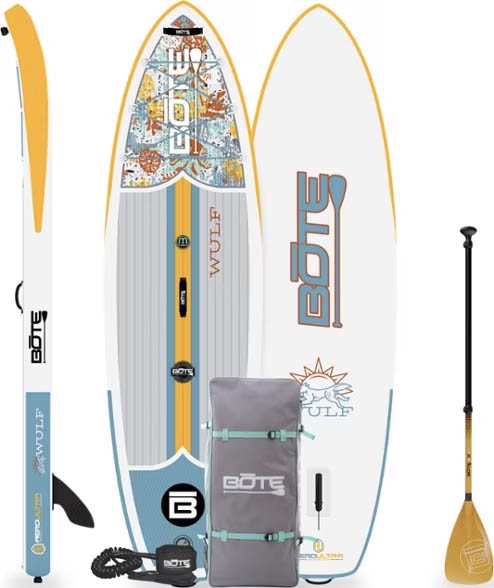 Category: Recreational
Category: Recreational
Length: 10’4”, 11'4"
Width: 33"
Fin: Single
What we like: A great-looking, capable all-rounder, often available through REI.
What we don’t: The Tower All Around S-Class above is a more affordable and durable option for beginners.
For recreational paddlers who want the ability to do it all, including fitness paddling, yoga, and casual flatwater cruising, a SUP like the Bote Wulf Aero is another quality choice. The Wulf has a fun deck design that consistently gets compliments and comes in a versatile 10-foot 4-inch size (it also comes in a 11’4” length) that’s ideal for paddlers up to 250 pounds—or a small adult paddler with a child or furry friend. You get the full suite of bells and whistles—multiple grab handles and D-rings, a front bungee, and a generous deck pad that we’ve found to be super grippy yet nicely cushioned for bare feet—and the fin attachment system is intuitive and secure. Finally, Bote is carried by REI Co-op, which means you can pop by your local store and get a feel for the board before you buy.
Our main gripe with the Bote is its single-layer design, which has a relatively low max PSI and can flex a bit under weight. By contrast, the Tower All Around S-Class above features a more durable and stable fusion construction (also termed “double-layer” by some companies) that should hold up better over time. And for inflation, we consistently ditch Bote's single-chamber pump for our more premium (and double-chamber) iRocker pump, which gets the job done faster and more easily achieves a higher PSI. But gripes aside, we’ve been pleased with our Wulf for everything from river floating to lake flotillas with the kids. For a more premium pick from Bote, their HD Aero is built with two layers of PVC for added durability and rigidity and tacks on features like a paddle sheath, accessory attachments, and a rear bungee.
See the Bote Wulf Aero 10'4"
 Category: Touring/specialty
Category: Touring/specialty
Lengths: 11’6”, 12'6"
Width: 30"
Fin: Single
What we like: A high-quality touring rig at a more affordable price.
What we don’t: Less stable than the all-rounders and budget designs above.
Paddlers who hit the water for long distances or multi-day trips need an expedition-ready feature set and proven performance, and the Thurso Surf Expedition 138 (which also comes in a 12’6” version called the Expedition 150) fits the bill. The Expedition is hardwearing with triple- and quadruple-layer PVC reinforcing the deck and sides (most boards have 1 to 2 layers), which gives it rigidity on par with a hard board. The Expedition also comes with functional and thoughtful features like a paddle holder, kayak seat attachment points, and an included carbon paddle. And the real draw for us is price. The Expedition is one of the most affordable high-performance designs on our list and will get you out onto the water for less than much of the competition.
It’s important to keep in mind that with a touring/expedition board like the Expedition 138, you lose some versatility for recreational cruising and activities like yoga, because the board’s dimensions result in less stability overall. And unlike many all-rounders here, the Expedition also has a half-size traction pad, which makes it harder to paddle with your dog or kids on board. But within its class, the Thurso is an impressively versatile design, with speed when you need it and plenty of tie-downs when you've got expedition gear on board. For a less performance-focused model, check out the Thurso Surf Waterwalker, which is offered in three different lengths from 10 to 11 feet.
See the Thurso Surf Expedition 138
 Category: Recreational/touring (hard board)
Category: Recreational/touring (hard board)
Lengths: 10'4", 11'4"
Width: 31"
Fin: Single
What we like: Nice balance of stability and speed—particularly for intermediate paddlers.
What we don’t: Pricey and doesn't come with a paddle.
Surftech’s Lido and Dax’s DownDog and Drifter above are great hard boards for beginners and those who enjoy mellow outings on flatwater, but the Surftech Chameleon is the better pick for intermediate to advanced paddlers looking for a faster and more playful ride. While the Lido’s planing hull prioritizes stability and easy maneuvering, the Chameleon features a displacement hull that’s more aerodynamic but still wide enough to maintain solid stability. Plus, with just a 4.5-inch thickness, the Chameleon sits lower in the water than thicker boards, allowing it to cut through the waterline. The net result is a faster yet still confidence-inspiring board that tracks well over long distances. Not to mention, it’s considerably lighter than the Lido and much easier to haul around (although inflatables still have the edge in portability).
However, the Chameleon still falls into a bit of an awkward in-between spot: It’s less stable than the Lido but also lacks the speed and tracking of a true touring setup like the Red Paddle Co Sport above. It also forgoes the Lido’s Utility Armor construction in favor of a less durable—but lighter-weight—fiberglass and epoxy build. Finally, despite its high price tag, the Chameleon doesn’t come with a paddle, leash, or fin. For nearly the same price, Pau Hana’s Malibu Tour (another hard board) features a sharper nose for better speed and tracking, comes with a paddle, and boasts Kevlar-reinforced rails for added durability. It’s also over a foot longer at 11’6”, which is good for stability but adds a significant amount of heft.
See the Surftech Chameleon 10'4"
 Category: Recreational
Category: Recreational
Length: 10’4”
Width: 35"
Fins: Tri (fixed side fins)
What we like: Great stability and flotation thanks to the 8-inch-thick platform.
What we don’t: Heavy and does not include a travel backpack.
Tower’s All Around is our top-ranked budget board, but if we had to choose, we’d take out the Xtreme 8” X-Class nine times out of ten. The reason for this is the Xtreme’s generous dimensions, which give you a really wide (35") and stable platform that can easily handle two paddlers, a dog, or some extra cargo. Most noticeably, the board is 8 inches thick, which adds a ton of flotation and stability compared to the majority of boards, which are 6 in. wide or thinner. You wouldn’t guess that you needed it, but after paddling the Xtreme, we’re fairly sold on the extra beefy design.
Importantly, the Xtreme is also a lot more durable than most inflatable boards here due to its double-layer, hand-glued construction. Technically, this also means that the Xtreme can be inflated to a very high pressure (up to 20 psi), although we haven’t been able to get it past 12 psi with the included pump. Weight is one of the biggest knocks of the Xtreme’s construction (it’s 29 lb.)—and the lack of a travel backpack really doesn’t help—but once the boat is on the water, this is a non-issue. All told, for larger paddlers or those who like the sounds of a stable ride, Tower’s Xtreme is worth a look.
See the Tower Xtreme 8" X-Class
 Category: Specialty
Category: Specialty
Length: 10’6”
Width: 35"
Fins: Tri
What we like: Reliable construction and tons of attachment points for accessories.
What we don’t: Wide and slow-moving; doesn’t come with a travel backpack.
For those wanting to take to the open waters with a fishing pole, a stand up paddle board is a relatively light, easy-to-transport vessel that allows the option to sit or stand. Any stand up paddle board here would technically get the job done, but dedicated anglers will benefit from the added stability and array of attachment points that specialty models offer. Sporting a three-fin setup, 450-pound weight capacity, a whopping 20 D-rings, and carbon paddle and rail for added stiffness, the iRocker Blackfin Model X is a true utility vehicle of a SUP. iRocker also makes it easy to tack on an assortment of compatible accessories, including a cooler deck bag, fishing rod holder, fishing rack, anchor, and even a kayak seat.
One of our gripes with the Blackfin is its lack of essential accessories, but we’re pleased to see it now includes a 10-inch leash, carbon paddle, and electric pump, which gives this board a serious bump in value-it still doesn’t come with a travel backpack, however. As far as speed is concerned, be sure to keep your expectations reasonable: With a generous 35-inch width and 6 inches between you and the water, the Blackfin Model X isn’t going anywhere super fast. If you need to travel a long distance to your fishing hole, it might be worth considering the Blackfin Model V instead, which is longer at 12’6” and features a narrower profile for more efficiency and speed. But for reeling in the day’s catch or paddling with a dog or child, the Model X’s spacious and stable deck certainly is a plus. Other dedicated fishing SUPs worth checking out include the Badfish Badfisher and NRS Heron, which adds 8-inch side bumpers to further boost stability.
See the iRocker Blackfin Model X
 Category: Recreational
Category: Recreational
Length: 10’
Width: 32"
Fins: Tri (fixed side fins)
What we like: A complete SUP package.
What we don’t: Only comes in one size and features are limited.
The Roc earns a spot on our list for its combination of quality and affordability. This paddle board is lightweight at 18 pounds, stable for a wide range of paddlers (it has a weight capacity of 350 lb.), and costs just $179 on Amazon at the time of publishing. And like most other designs here, the Explorer comes ready to hit the water with an aluminum paddle, hand pump, leash, backpack, and even a small waterproof bag to keep your valuables dry. You can find other SUPs on Amazon for even less, but the Explorer is a great balance of quality and value, and Roc offers the added assurance of a dedicated customer service team and one-year warranty.
It’s true that the Roc Explorer is a fraction of the cost of many of our top picks, but a budget design comes with its fair share of trade-offs. Notably, you only get a few D-rings, one grab handle, and a relatively short, 10-foot length. The Explorer also uses single-layer construction, which isn't particularly durable and will lose its shape over time. But the Explorer is another great package deal for penny pinchers just getting started, and it’s for good reason that we frequently see it out on the water.
See the Roc Outdoors 10' Explorer
| Stand Up Paddle Board | Price | Category | Length(s) | Width | Weight | Fins | Paddle |
|---|---|---|---|---|---|---|---|
| iRocker All-Around 11' | $700 | Recreational | 10', 11' | 32" | 26 lb. | Tri | Yes |
| Tower All Around S-Class | $399 | Recreational | 10'4" | 32" | 20 lb. | Tri | Yes |
| Red Paddle Co Sport 11'3" | $1,099 | Touring | 11', 11’3”, 12'6", 14'0" | 32" | 24 lb. 14.6 oz. | Single | No |
| Kokopelli Chasm-Lite | $999 | Specialty | 10' | 30" | 12 lb. 14.0 oz. | Single | Yes |
| Tahe 10’6” Beach SUP-Yak | $700 | Rec/specialty | 10’6” | 34" | 23 lb. | Tri | Yes |
| Dax DownDog 11’6” | $899 | Rec/special (hard) | 10’6”, 11’6” | 33" | 27 lb. | One | No |
| Isle Pioneer 3 | $695 | Recreational | 10'6" | 34" | 19 lb. | Single | Yes |
| Dax Drifter 11'6" | $1,099 | Red (hard) | 10’6”, 11’0”, 11’6” | 33" | 26 lb. | Single | No |
| Surftech Lido 10'6" | $875 | Rec (hard) | 10'6", 11'6" | 33" | 28 lb. | Single | No |
| Bote Wulf Aero 10'4" | $559 | Recreational | 10'4", 11'4" | 33" | 20 lb. | Single | Yes |
| Thurso Surf Expedition 138 | $750 | Touring/specialty | 11'6", 12'6" | 30" | 21 lb. | Single | Yes |
| Surftech Chameleon 10'4" | $1,185 | Rec/tour (hard) | 10'4", 11'4" | 31" | 23 lb. | Single | No |
| Tower Xtreme 8” X-Class | $549 | Recreational | 10'4" | 35" | 29 lb. | Tri | Yes |
| iRocker Blackfin Model X | $799 | Specialty | 10'6" | 35" | 27 lb. | Tri | Yes |
| Roc Outdoors 10' Explorer | $600 | Recreational | 10' | 32" | 18 lb. | Tri | Yes |
Our adventurous team of reviewers at Switchback Travel saw stand up paddle boarding surge in popularity in recent years, and we couldn’t wait to jump on board—both literally and figuratively. Former senior editor Jenny Abegg collaborated with Beth Price of Beth Price Photography to put together our initial list featuring 14 of the top paddle boards in 2022. Based in the Pacific Northwest, Jenny isn’t deterred by long hikes to access serene alpine lakes and uncrowded waterways. Editor Maddie Downie took over the guide in 2024. Now based in Washington state, Maddie grew up spending hot Colorado summers paddle boarding on lakes and reservoirs throughout the Front Range, with her favorite being Horsetooth Reservoir just outside Fort Collins.
Our collective experiences on the water—along with feedback from contributors and the online paddle board community—helped us whittle down our list to the 15 picks you see above. When we put stand up paddle boards to the test, we look at basic characteristics like hull shape, board size, and weight. We also evaluate overall functionality in a variety of conditions, from glassy lakes to mellow whitewater, and take into account which accessories (if any) are included with purchase. To reflect the wide variety of paddle boards and paddle boarders, we’ve included everything from entry-level options for those just starting out to specialty designs for backcountry exploration. As the market changes, we will continue putting new and noteworthy designs to the test, adding any standouts to the list as we go.

Stand up paddle boards (SUPs) run the gamut from entry-level cruisers ideal for flatwater floating to sleek 14-foot models built to slice efficiently through the water. To narrow down which style is best for you, you’ll want to identify what kind of water you’ll be paddling—flatwater, whitewater, ocean waves, etc.—and what type(s) of activities you’ll be doing while on your board—fishing, yoga, cruising, or multi-day tours, for example. To help, we’ve broken down our picks into three main categories: recreational, specialty, and touring.
Recreational
By far, the most popular style of paddle board is the recreational board, built for casual use, flatwater cruising, and mellow whitewater use. Recreational boards have a rounded, planing-style hull (for more, see our section on “Hull Shape” below), are between around 9.5 and 11 feet long, have widths of 30 to 34 inches, and generally come with three fins for added stability. If you’re going to own just one SUP, boards in this category are far and away the most versatile. And there’s no shortage of options available, from premium models like the iRocker All-Around 11' to budget boards like the Tower All Around S-Class.
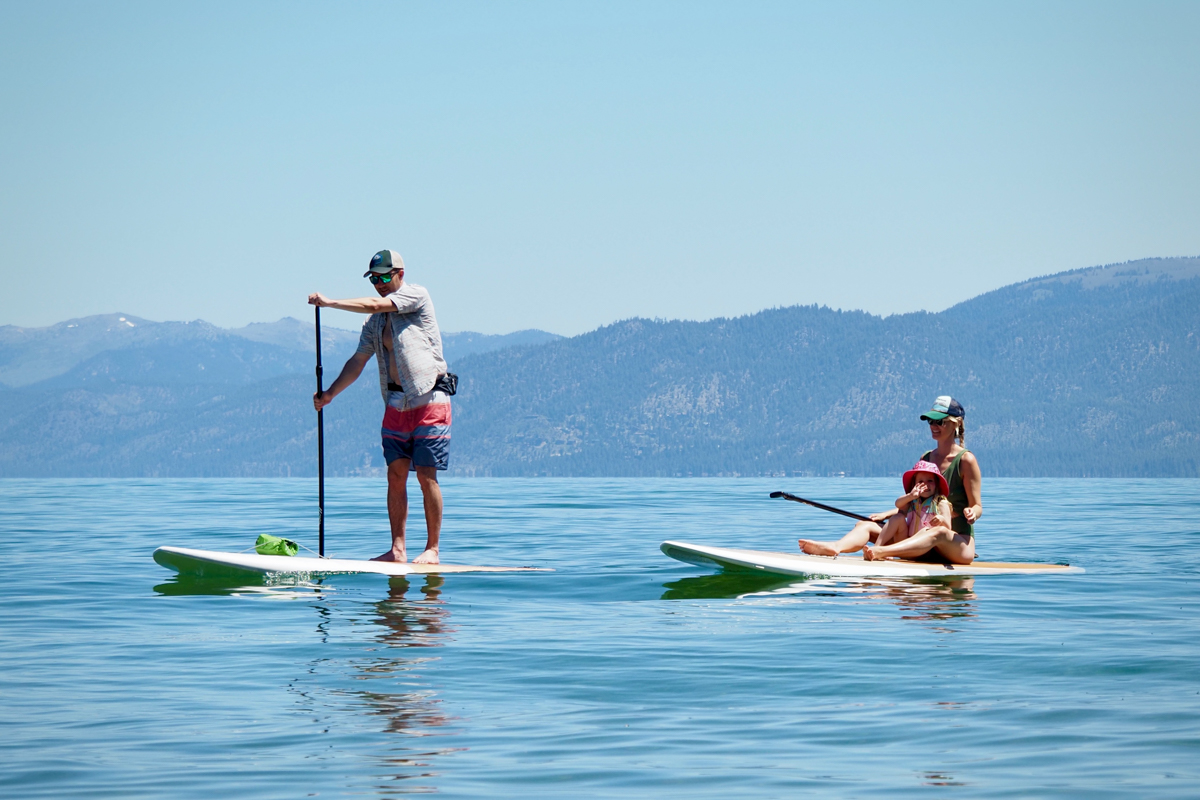
Specialty
Our specialty category is a catch-all for boards designed for activities like yoga, fishing, surfing, and whitewater. For many of these activities, you can get away with using a recreational board, but committed yogis, anglers, surfers, and expedition-goers will value the sport-specific deck styles, attachment points, and extra features of a dedicated model.
More specifically, if you plan to do yoga on your board, you’ll want to look for a generous deck pad with a relatively flat surface (deep grooves will be uncomfortable against your skin), a center handle that lies flat (some come with handles along the edges instead), and a bungee system at one end to keep belongings safe—Dax’s DownDog is one of our favorites in this category. Anglers will want a board like the iRocker Blackfin Model X that features fishing rack attachment points, multiple bungee systems and an assortment of D-rings, and perhaps the option for a kayak seat. Finally, those tackling whitewater or heading out on long expeditions will be best matched with models that feature a single fin, durable construction, and no shortage of deck tie-down points.
Touring
Whether you use your SUP for daily fitness or multi-day camping trips, if you’re logging miles on the water, you’ll likely want a touring-focused design. In general, these boards are longer than recreational SUPs (usually in the 11-14-ft. range), narrower (less than 32 in. wide), and use a single fin for excellent speed and tracking. Some also feature a high weight capacity (for example, the Thurso Expedition can handle 330 lb.) and lots of bungees and tie-down points, which helps to accommodate extra gear for those who like to go far and fast. Most of these designs also have a tapered nose that still maintains a bit of a rocker, but the speediest feature displacement hulls like that of the Thurso Surf Expedition 138.

On our list above, we’ve included everything from high-end boards like the Surftech Chameleon, which runs $1,185 at full price, to entry-level designs like the Roc Outdoors Explorer, which can be found on sale for only $179 on Amazon at the time of publishing. With paddle boards (as with most outdoor gear), you do get what you pay for: Budget boards typically have thin, single-layer constructions and come with heavy plastic or aluminum paddles. While these boards make inherent sacrifices in durability and rigidity, most recreational paddlers really don’t need anything more for casual floats. That said, if you’re looking for top-notch performance for activities like touring, yoga, or surfing, we recommend spending up for one of the more premium (read: pricier) models. Along with a more solid build, these boards will get you a design purpose-built for what you need it for—be it speed, white water-worthiness, or a flat and stable surface for downward dog.
If you’ve already started your research, you might’ve noticed that many brands feature sales on virtually all their boards. This is sometimes a strategy to make buyers feel like they’re getting a good deal, but that’s not to say there aren’t genuine steals to be found online. If the board of your dreams seems too pricey, it's worth diving in a little more to see if you can find a discounted offering. Also, be aware that many of the higher-end brands offer excellent customer service and multi-year warranties, both of which are worth taking into account from a long-term investment standpoint.

Length
Most recreational paddle boards are between 9 and 11 feet long, while touring- and racing-focused designs can be as long as 14 feet, like Red Paddle Co’s Sport 14’0”. A basic rule of thumb is as follows: The shorter the board, the less surface area it will have and the more maneuverable it will be. Other dimensions like width and thickness matter too, but generally speaking, shorter boards excel on flat water where you don’t need the extra stability (a super long board can be overkill for casual paddling), while longer models travel straighter and faster and are favored for open water and touring.
In addition to the category of board and intended use, choosing the right length of your SUP depends on the weight of the person riding it. Many manufacturers provide a recommended weight range: The Surftech Lido, for example, recommends the 10'6" version for up to 300 pounds and the 11'6" version for up to 350 pounds (importantly, this includes the weight of both paddler and gear). Simply put, a shorter board is lighter and has less surface area, so heavier paddlers will push it farther down into the water, making it less stable and more difficult to ride. Once you’ve settled on your desired style of board and even the specific model, you can choose a final length based on the paddler. And keep in mind that not all boards are offered in multiple lengths, but we certainly appreciate the option when they are.
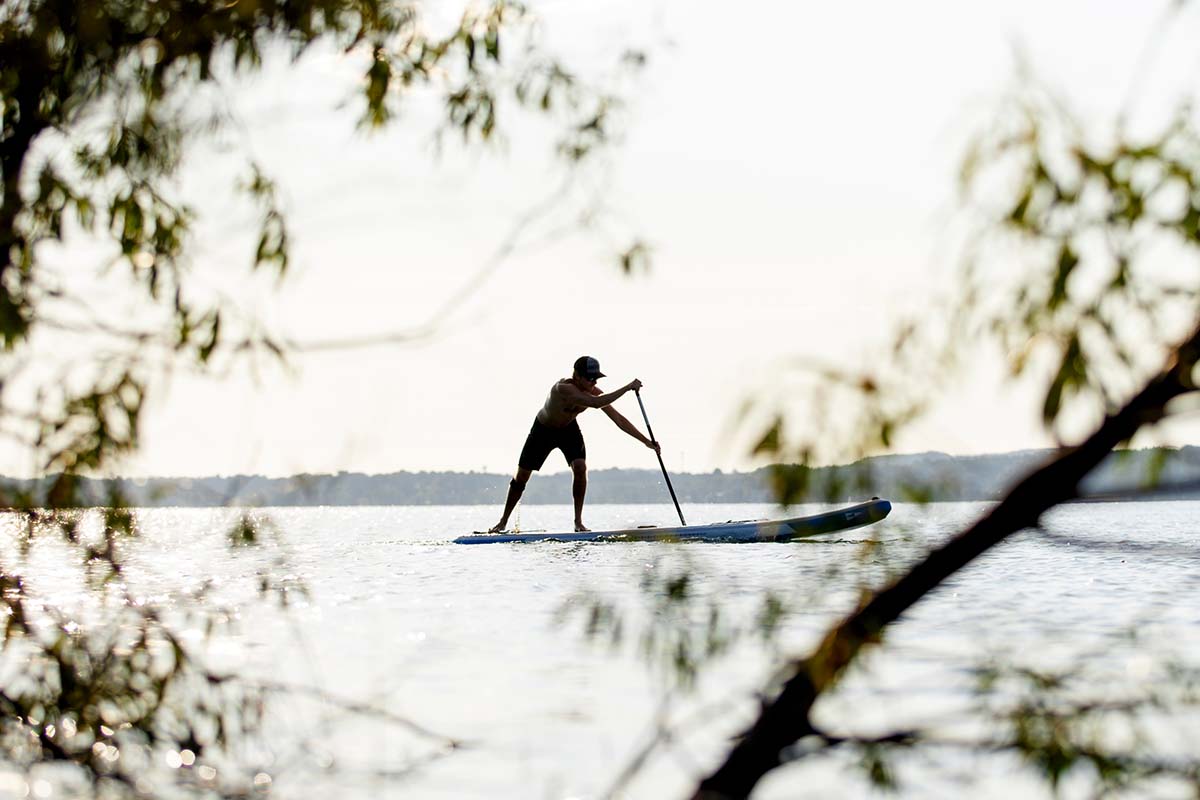
Width
Most recreational and specialty SUPs are between 32 and 35 inches wide, while touring designs are as narrow as 25 inches. Again, generally speaking, a narrower board will be faster while a wider board will be more stable. If you’re just starting out, we recommend sticking with a board with a width around 32 inches, such as the iRocker All-Around, which will provide ample maneuverability without making you feel unbalanced.
Thickness
Most inflatable stand up paddle boards are 6 inches thick, but our list spans from 4.7 to 8 inches for the Tower Xtreme X-Class. It’s important to find the sweet spot here: You’ll know a board isn’t right for you if you feel like you’re sinking (too thin) or like your center of gravity is too high off the water (too thick). In general, smaller paddlers will want to opt for a thinner board, while heavier paddlers will want to bump up to a thicker (6 to 8-in.) board. And finally, it’s important to keep in mind that many budget boards will create stability by increasing thickness rather than using higher-quality materials. It’s a shortcut, and certainly has its downsides—if a board is too thick, it can feel unwieldy and boat-like on the water.
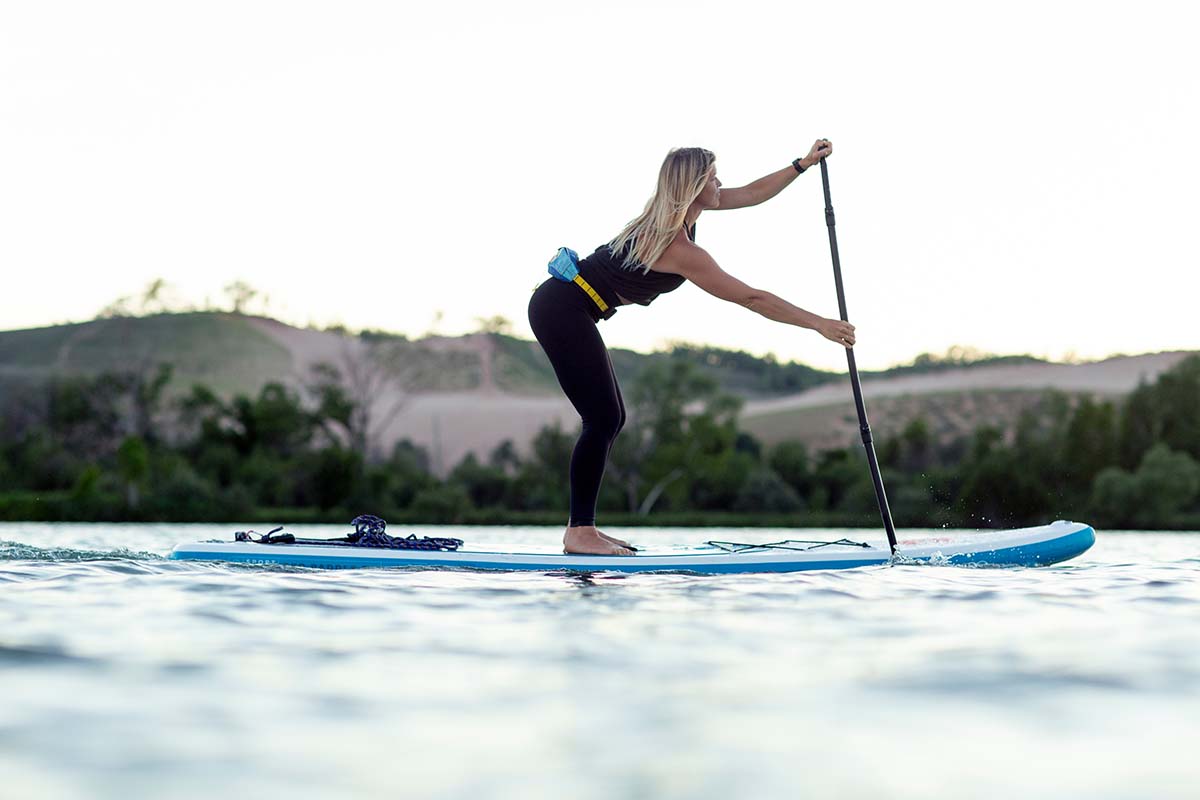
Volume
An inflatable paddle board's volume is a measurement of its buoyancy and ranges from about 160 to 380 liters for inflatable models (keep in mind that this number varies for hard boards). A board with too little volume (especially one with a displacement hull) will drag and move inefficiently through the water, while one with too much will feel noticeably unstable, imbalanced, and difficult to control. As a general rule, most paddlers can multiply their weight plus the weight of their gear in pounds by 1.4 in order to determine their maximum volume. For example, a 180-pound paddler with 10 pounds of gear should look for a board with a volume of 266 liters or less (190 x 1.4 = 266). And thankfully, most manufacturers specify a board’s weight capacity alongside its volume, which minimizes the guesswork.
Stand up paddle boards have one of two main hull shapes: planing or displacement. The lion's share of stand up paddle boards fall into the planing category, which means their nose is wider, flatter, and has a round, rockered tip to float on top of the water. This shape is great for stability and maneuverability and does a nice job keeping the board afloat on choppy water. SUPs with planing hulls are typically designed for recreational cruising as well as sports like yoga, fishing, and surfing.

Displacement hulls, on the other hand, are pointed (similar to a kayak) and built to cut through the water with their aerodynamic shape. These are designed to go in a straight line and are a great match for those concerned with speed, with the major downside being less stability. For activities like touring, racing, or even logging fitness miles on your local waterway, a paddle board with a displacement hull is without a doubt the best match. Finally, some of the most versatile boards (the Surftech Chameleon, for example) merge the two hull styles for a combination of both speed and stability.
Paddle boards range in weight from around 13 pounds (the Kokopelli Chasm-Lite tips the scales at 12 lb. 14.4 oz.) to upwards of 30. You can tell a lot about a board from its weight—in general, those with beefier (read: more durable) constructions will weigh significantly more than those with single-layer builds. In terms of packability, the most compact inflatable boards fit into a carry-on-sized pack, while others are so large that they need a roller bag to transport. Weight and packed size won’t be top considerations for everyone, but they are critical for travelers, paddlers who plan to tote their paddle board long distances before putting in, or those limited on storage space in/on their vehicle. Note: Keep in mind that hard boards are much tricker to transport as they can’t be packed down into a travel bag. In most cases, they require a rack on a car and a trustworthy strapping system to get to the water.
Despite their nature, stand up inflatable paddle boards are not your standard blow-up pool toy. In order to achieve rigidity on par with hard boards, inflatable models use an innovative technology called “drop-stitch” construction. Here, two sheets of fabric (the top and bottom) are connected by thousands of threads, which give the board its structure. The edges of these sheets of fabric are then joined by a narrow strip of material on each side (“rails”) and coated with liquid PVC. Higher-quality boards are most often made with two layers of PVC (dubbed “double-layer”), which increases durability and stiffness. At the premium end of the market, some manufacturers add a third or fourth layer or a hybrid layer (such as Red Paddle Co’s MSL Fusion or Isle's Airtech Prolite) to their construction, and some paddle boards even feature stiffening strips to add onto the rails for increased rigidity.
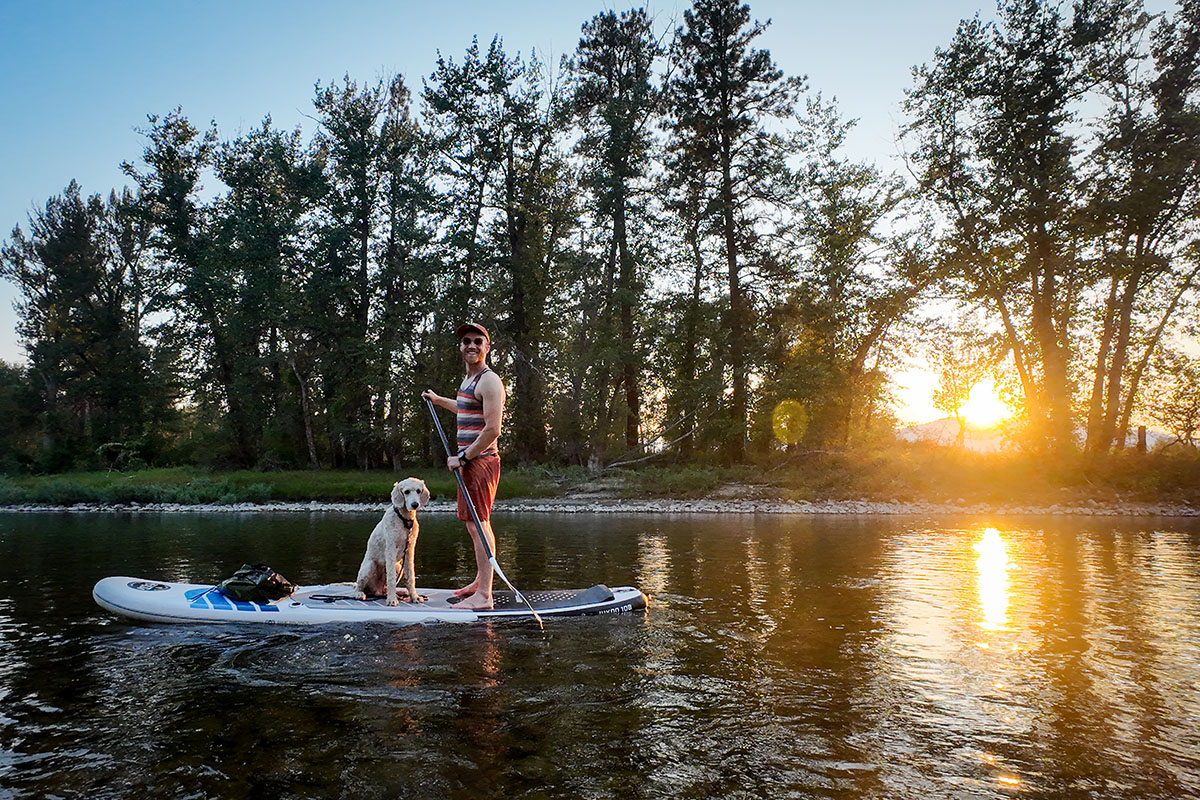
This might come as a surprise to many, but inflatable paddle boards are actually incredibly durable pieces of gear. In fact, there’s a big argument that they're more robust than hard boards, as they’re able to give upon impact and can be transported and stored away from the elements. Even budget-friendly, single-layer boards are reasonably hardwearing and long-lasting, and it’s rare to see inflatable SUPs form a leak from standard wear and tear. That said, it’s always important to keep a repair kit on hand (as we outline below), since one small leak can have major implications.
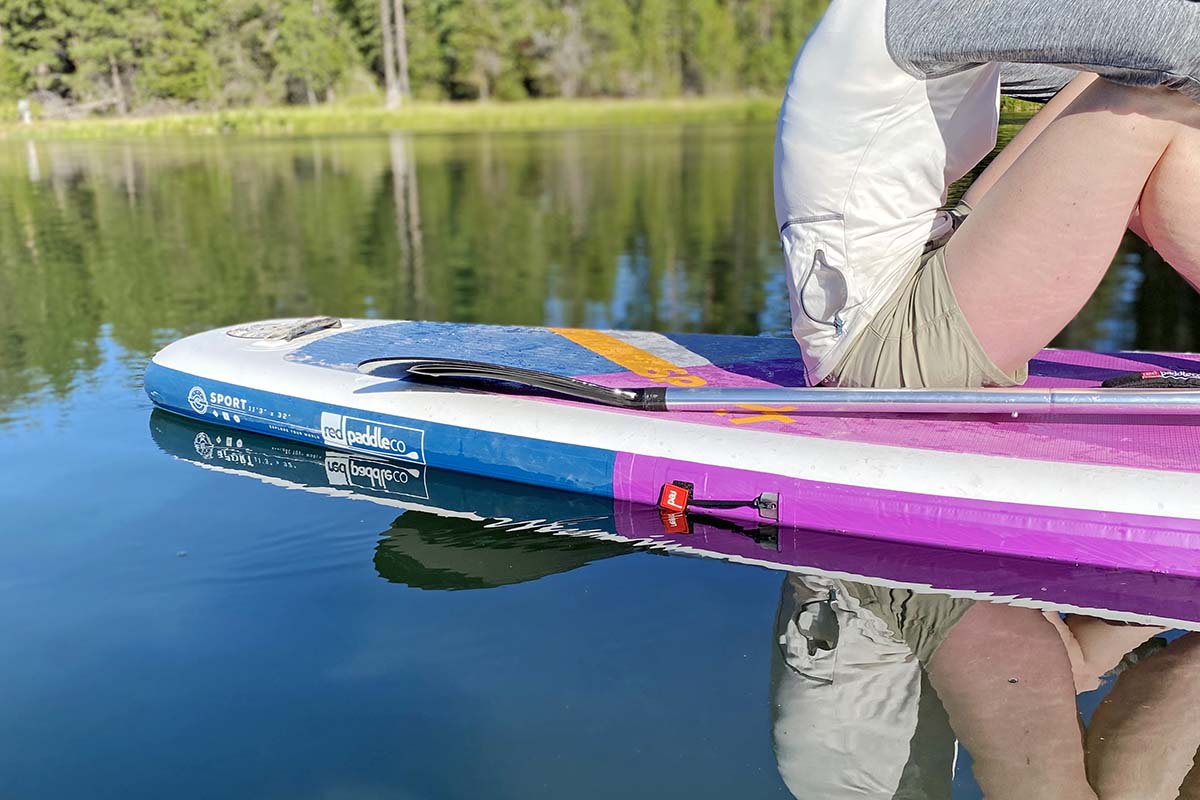
Every paddle board on our list comes with at least one fin, and many will have two or three. A single fin is great for flatwater paddling, moving in a straight path (also known as tracking), and keeping speed up (fewer fins means less drag). For this reason, most touring and racing models will have just a single fin, including the Red Paddle Co Sport. Boards with three fins can be divided into a couple different categories—“thruster” setups have three equally sized fins, while 2+1 configurations have a large center fin and two small fins on each side—but for the purposes of this article, we’ve lumped them together into the tri-fin category. Tri-fin setups offer great stability and maneuverability but aren’t great at tracking and are often found on recreational and specialty boards. Finally, a twin-fin layout has a fin on each side but none in the middle, resulting in a highly maneuverable board and often great clearance in shallow water (side fins are usually smaller than a center fin).
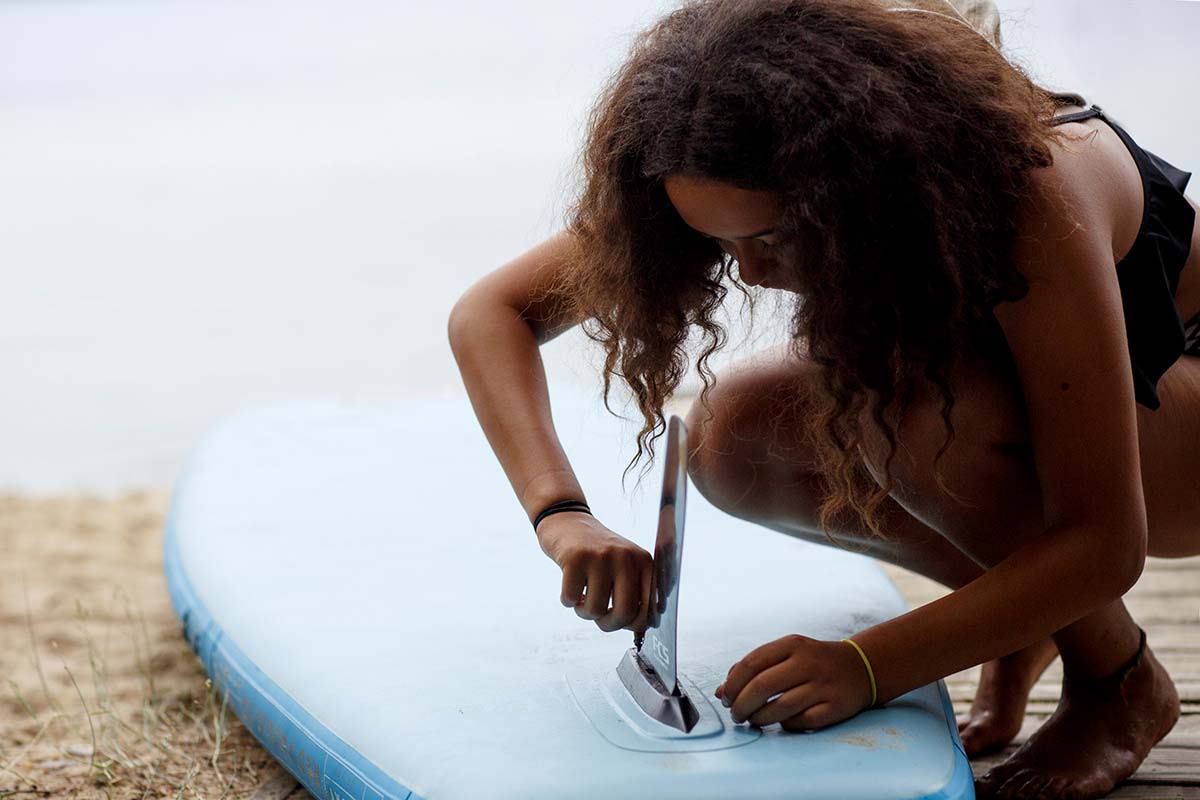
If you’re just starting out, it’s likely that you’ll opt for a board with a tri-fin setup, whether it’s a thruster or a 2+1. Some boards come with fixed side fins, while others have the option to remove or swap them out with those of different sizes (unless we specifically call out fins as fixed, you can assume they are removable). Removable fins are great for customizing your ride and recommended for intermediate to advanced paddlers: Our favorite configuration is a removable tri-fin design—with this setup, you can run your board with a single fin, twin fins, or all three depending on your paddling needs and the water conditions. For the maximum amount of customization, it’s worth looking for a board with standard U.S. Fin Boxes so you can easily swap out a wide range of fins.
It’s easy to get lost in the technical jargon regarding an inflatable paddle board's construction, but the good news is that every board comes with a simple clue that points to its overall level of quality: psi. Psi, or pounds per square inch, is a measure of air pressure: The higher the psi, the stiffer the board will be when fully inflated (with inflatable paddle boards, stiffer is better). Premium boards are often made with multiple layers and well-constructed seams and will be able to inflate to a higher psi, while budget boards typically have a lower air capacity. For reference, the maximum psi of a single-layer SUP will be around 12 to 15, while double-layer designs can have a psi of over 20.
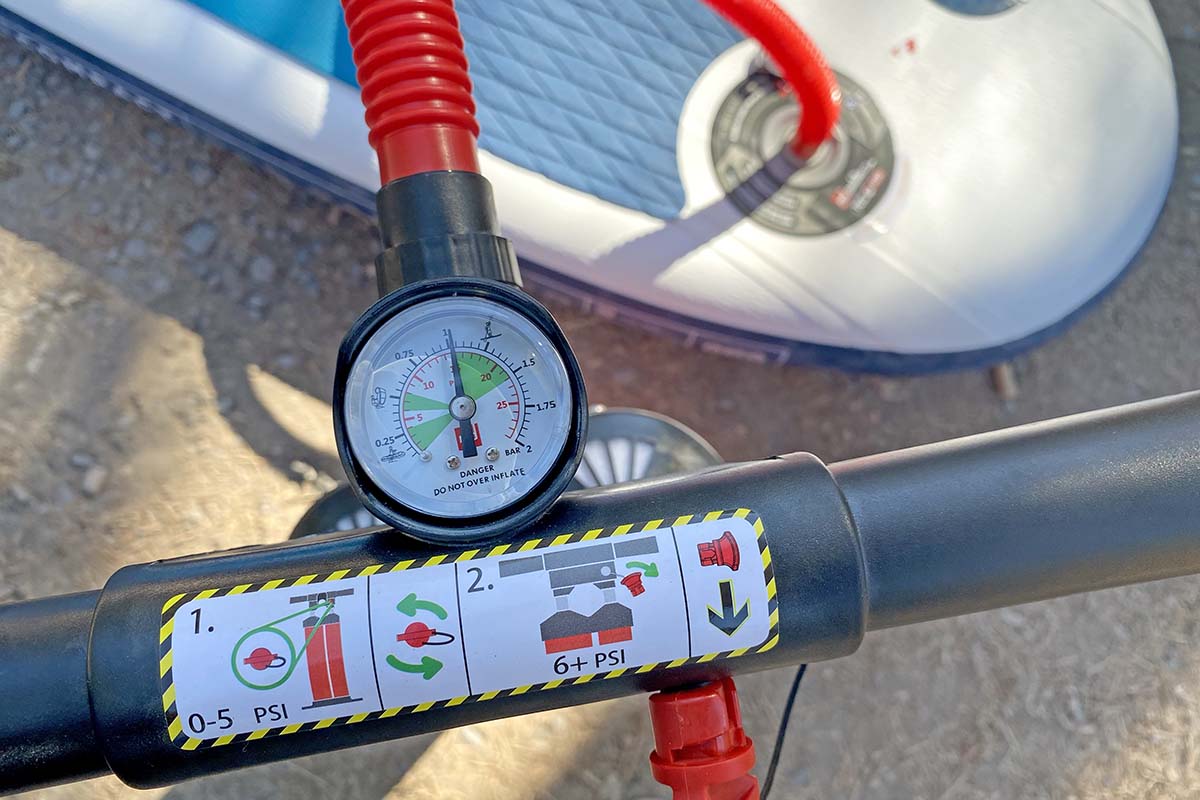
The vast majority of inflatable paddle boards come with a manual pump, which have one or two cylinders and are generally dual action, meaning you’re sending air into the board on both the down and up strokes. Most pumps have a built-in pressure gauge, and some even have two modes—high-volume and high-pressure—to help you inflate your board to the manufacturer-recommended psi. We vastly prefer dual-chamber pumps to the single-chamber variety, and in our experience, twice the cylinders is truly twice the performance. For example, we struggle to inflate our Hala Asana to 10 psi with the included single-chamber pump, but with Red Paddle Co's Titan pump, we can get our Sport 11'3" to 18 psi without too much time or effort. Finally, those taking their board on longer expeditions will likely want a travel-sized design (like the K-Pump K-100) for maintenance and in case of leaks.

Some paddlers might find it worthwhile to invest in an electric pump, especially those who get out often or want to inflate their board to the maximum psi. Look at it this way: If you’re going to spend over $1,000 on an inflatable paddle board that’s valued for its rigidity, you might as well go the extra mile to make sure you’re getting the most out of your investment. Electric pumps are purchased separately and run the gamut from budget-friendly models like the $37 Advanced Elements 12 Volt Electric Pump to premium options like the Outdoor Master Shark II Electric SUP Pump (around $105).
In terms of functionality, most electric pumps plug into power during inflation (a standard wall plug-in, your car battery, or your vehicle’s cigarette lighter), although some have a built-in battery so that they can be charged at home and used without a power source in the field. Most electric pumps take a little less than 10 minutes for a standard-sized paddle board, and their hands-free nature means you can walk away and come back to a fully inflated board. And while electric pumps are certainly the more efficient option, you’ll want to read the specs before buying—some can inflate boards up to 20 psi, while others max out at 15 psi.

When shopping for a paddle board, it’s a good idea to take a close look at what’s included in your purchase. Most inflatable SUPs come with a backpack or roller bag for storage and transport along with a hand pump and fins, and many will also include a paddle, pump, leash, repair kit, and more. It’s important to keep in mind that all of these are essential pieces of gear, and if they don’t come with your board, you’ll almost certainly want to purchase them separately.
Backpack/Roller Bag
Nearly all inflatable paddle boards come with a backpack or roller bag for easy storage and transportation. We’ve found that the quality of these products varies significantly, and if you think you’ll be putting yours to good use by carrying your board for long distances or over rougher terrain, it’s a good idea to make sure it’s up to the task. In general, most included backpacks lack the adjustability and load-bearing suspension we’re used to seeing in backpacking packs and are typically only serviceable for short schleps from the car to the water. If you anticipate hiking before putting in, it’s worth considering an ultralight SUP like the Kokopelli Chasm-Lite, which comes in a streamlined package that packs down to a little larger than a roll of paper towels.

Paddle
Most—but not all—stand up paddle boards on the list above come with a paddle, and these are typically two or three-piece designs and adjustable. Depending on the price of the board, paddles range from heavier plastic or aluminum to lightweight fiberglass or carbon. Most recreational paddlers choose to keep the paddle that comes with their board, but performance-focused SUPers headed out on longer or more intensive missions often upgrade to a lighter or more powerful model. Lightweight paddles are usually made with carbon shafts or blades (or both) to shave weight without compromising strength.
In selecting the ideal blade, you’ll want to consider the size, shape, and offset (the angle of the blade with respect to the shaft). In general, larger paddlers will want a larger blade (more power in the water), while smaller paddlers will be more efficient with a smaller blade. And as for fit: A good rule of thumb for recreational paddlers is to add 8-12 inches onto your height, or measure from the ground to the crook of your wrist when your arm is raised in the air.

Leash
The primary function of a leash is to keep your board attached to you in the event of a fall. These are less important in flatwater, but can be a matter of safety in the ocean or in fast-moving sections of river. Some boards will come with a leash, while others will require you to purchase separately. When shopping for a leash, we recommend looking for a model in the 8- to 10-foot range with a coiled cord that will drag less in the water. High-quality leashes will also include a swivel between the cuff and the cord, which keeps the cord from tangling.
Repair Kit
Most inflatable SUPs also come with a small repair kit, which often includes items like PVC patches, a brush or cleaning solution (such as an alcohol swab), and sometimes even a valve tool to adjust your inflation/deflation valve(s). Interestingly, glue must be purchased separately due to shipping regulations, but you can find a product like Clifton's Urethane Adhesive at your local hardware store or on Amazon for relatively cheap. Getting a hole in your inflatable board isn’t the end of the world, but you’ll want to be well-versed in repair should you spring a leak on the water (NRS has a great how-to video here).
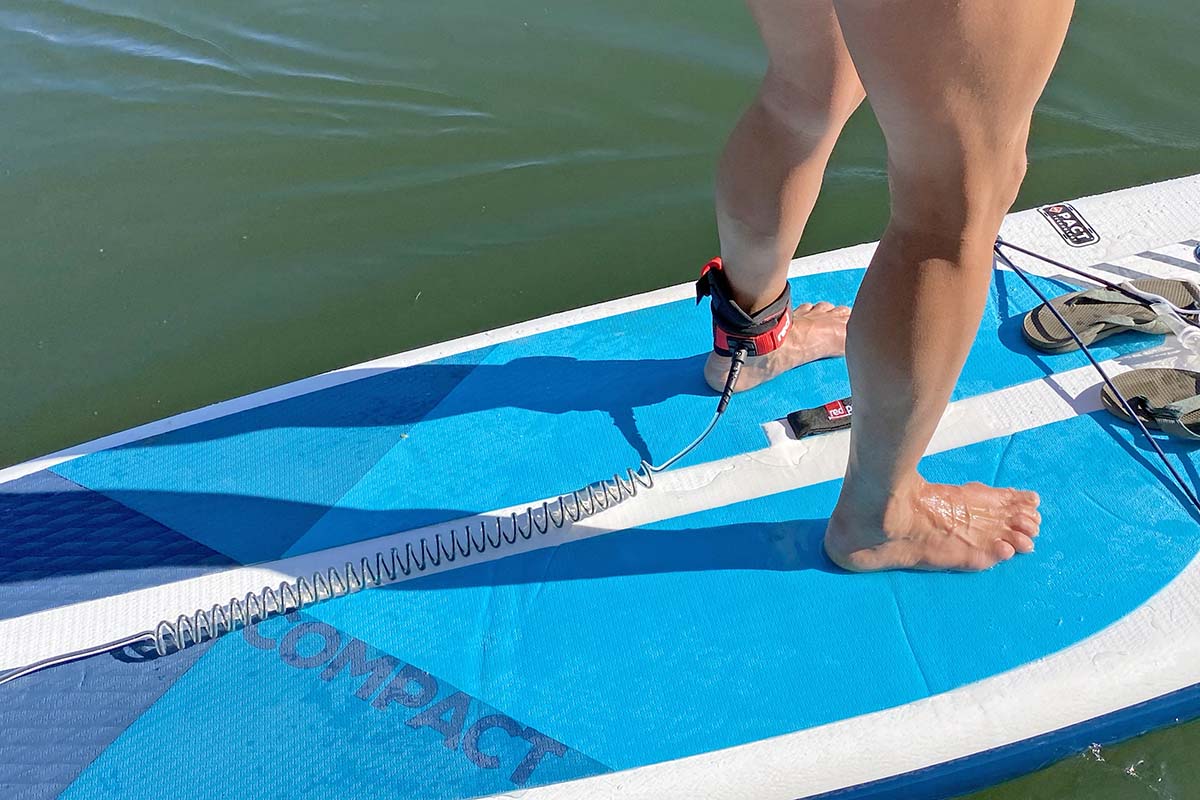
All stand up paddle boards are designed with features like a deck pad, carry handle, and leash attachment point, but there are a lot more bells and whistles worth considering. For instance, even casual cruisers will appreciate having extra rigging points, whether it’s a bungee tie-down or D-rings (or both) for stashing gear on deck. These are often located on the front or back of the board and great for securing your water bottle, sandals, or waterproof stuff sack full of valuables. Second, some boards feature mounts specifically designed to be compatible with fishing rod holders, GoPro cameras, coolers, kayak seats, and more, and these add-ons can often be purchased separately through the same manufacturer. For example, our favorite fishing SUP, the iRocker Blackfin Model X, has 20 attachment points and a fishing rack attachment that stores items like rods, a bucket, and a cooler.

Many paddlers wear a PFD (or personal floatation device) for safety—in fact, a good number of lakes and reservoirs require them. Because standard PFDs can be uncomfortable and restrictive, many paddlers opt for belt-style or inflatable vest designs that are low-profile. When shopping, you’ll want to look for a belt or vest with a Type III or Type V U.S. Coast Guard rating, like the Mustang Survival Fluid Manual Inflatable Belt Pack (Type III) or the NRS Otto Matik Inflatable PFD (Type V).
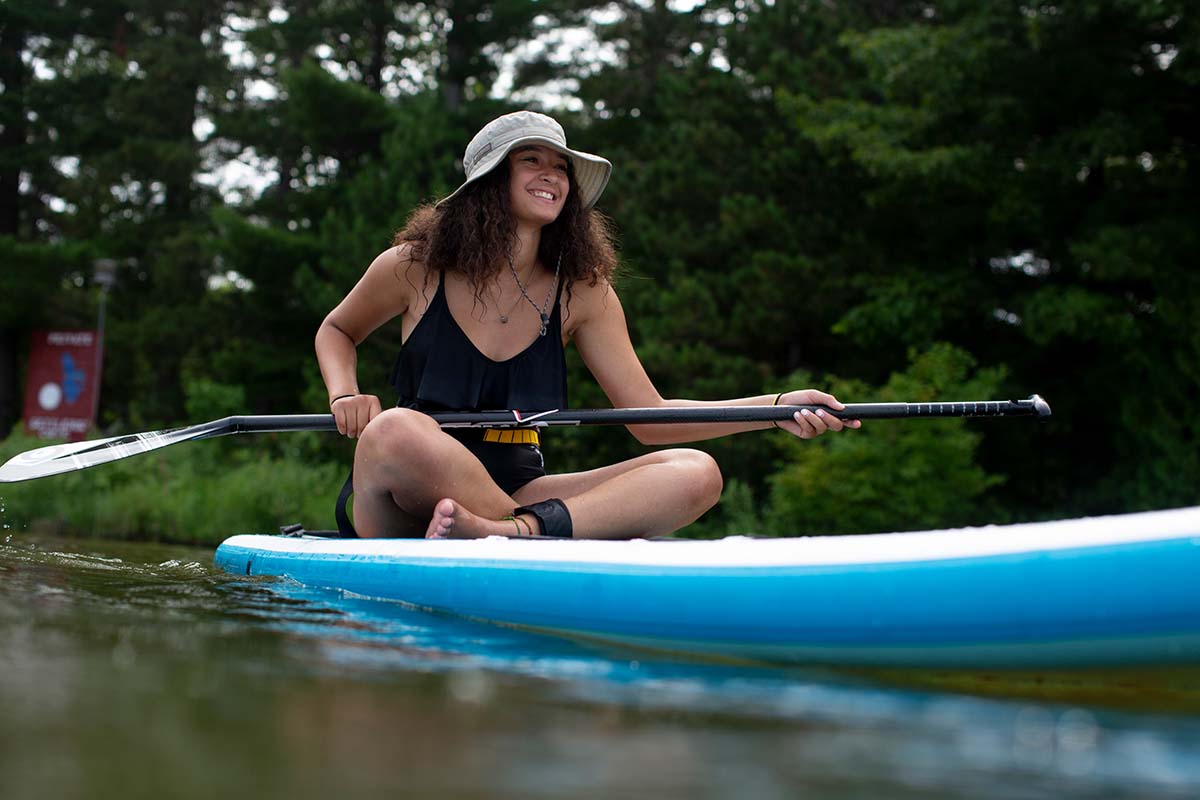
Stand up paddle boarding is an excellent activity to do with your family, but most smaller paddlers will find it challenging to maneuver standard 10- to 11-foot vessels. Thankfully, manufacturers now make paddle boards specifically for kids. Most kids-specific boards prioritize stability above speed, and are 8 to 9 feet in length, around 4 inches in depth, and weigh under 20 pounds. Unless you’re a particularly intrepid family, kids boards are a great place to focus on affordability over serious build quality. Keeping price in mind, a few of our favorite models include the Retrospec Weekender Nano ($230) and the Thurso Surf Prodigy Junior ($449). If cost is your most important factor, it’s also worth considering the Roc Outdoors Explorer, a stable, 10-foot board that’s available for only $179 on Amazon at the time of publishing.

A major debate you’ll likely have when shopping for a stand up paddle board is whether you want a solid or inflatable construction. Solid boards (like the Dax Drifter and Surftech Lido) are usually made with an EPS foam core wrapped in fiberglass and epoxy (like a surfboard). Less common materials include carbon fiber, plastic, and wood. The benefits to solid boards are clear: They have little to no give, are more efficient in the water (less drag), don’t require any setup, and won’t pop. However, the obvious drawback is that hard boards don’t pack down, meaning you’ll need a roof rack or large truck bed for transport and ample storage space at home. In general, they’re slightly more expensive than inflatable models, too, although costs are fairly comparable across the board.
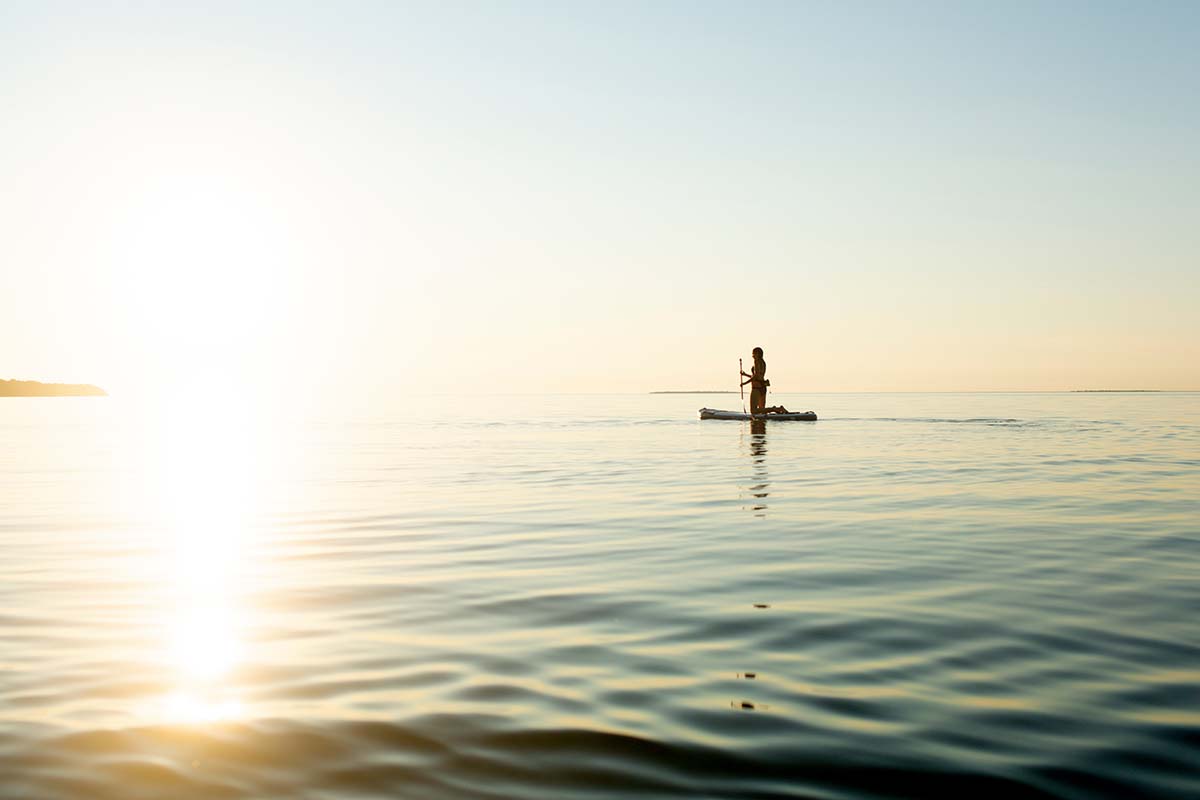
While hard boards certainly have their place, inflatable designs have taken the market by storm for a few main reasons. Most obviously, they pack down into a reasonable size and fit into an accompanying backpack or roller bag, which frees up valuable storage space and makes them much easier to transport. Second, due to their construction, inflatable paddle boards provide a bit more stability on both flatwater and whitewater, and their soft feel and flat surface (unlike the tapered top of a solid board) make them ideal for recreational cruising and activities like yoga. Finally, inflatable SUPs are generally both more affordable and longer-lasting than solid paddle boards. For these reasons, 11 out of the 15 picks above are inflatable designs.
Editor's note: This article, including several photos in our Buying Advice, was done in collaboration with Beth Price of Beth Price Photography. Visit Beth's website to check out her beautiful work documenting outdoor life in northern Michigan.
Back to Our Stand Up Paddle Board Picks Back to Our SUP Comparison Table